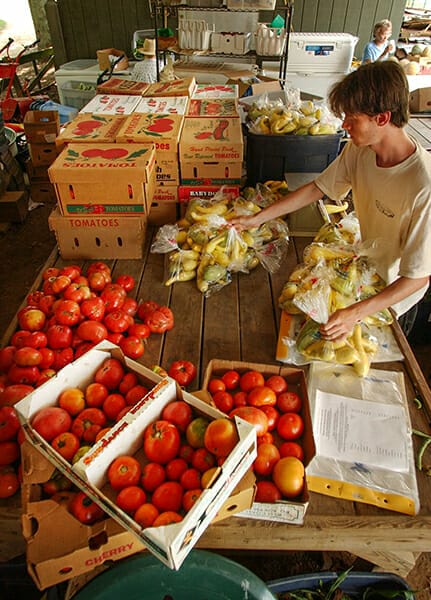Community-Supported Agriculture
An increasing number of farms in Alabama are adopting the community-supported agriculture (CSA) model to help fund their operations and market their products. CSA offers members, such as local residents or individuals recruited from metropolitan areas, a share of a farm’s harvests in exchange for an investment in the farm at the beginning of the season. Farmers appreciate the up-front investment, the chance to connect with their customers, and the knowledge that at least part of their crop has been sold. Customers and members enjoy the regular supply of farm-fresh produce and a personal connection to the farm that grows their food.
 Collards at Red Root Farm
Though the CSA concept has been growing in popularity in Alabama and the United States for more than 25 years, the model arose in the 1960s in Europe and Japan and was only introduced to the United States in the mid-1980s. Some of the earliest CSA farms in the United States were located in Alabama. Tuscaloosa CSA in Coker started in 1989 and Bee Natural Farm, a CSA enterprise in Fairhope, began operations around the same time. They are also some of the oldest organic farms in the state, at least since the word “organic” was adopted to describe this type of farming. The CSA model provided a good marketing option for both farms, which had few outlets for their organically grown produce, a farming practice almost universal among CSA enterprises. As interest in organic farming has grown in Alabama, so has interest in the CSA model. Alabama is now home to at least 20 CSA projects, with memberships ranging from 12 to more than 200 individuals. Although CSA in Alabama and the Southeast in general is not as popular as in other regions of the country, particularly the Northeast and West Coast, many Alabama CSA farms have waiting lists to join.
Collards at Red Root Farm
Though the CSA concept has been growing in popularity in Alabama and the United States for more than 25 years, the model arose in the 1960s in Europe and Japan and was only introduced to the United States in the mid-1980s. Some of the earliest CSA farms in the United States were located in Alabama. Tuscaloosa CSA in Coker started in 1989 and Bee Natural Farm, a CSA enterprise in Fairhope, began operations around the same time. They are also some of the oldest organic farms in the state, at least since the word “organic” was adopted to describe this type of farming. The CSA model provided a good marketing option for both farms, which had few outlets for their organically grown produce, a farming practice almost universal among CSA enterprises. As interest in organic farming has grown in Alabama, so has interest in the CSA model. Alabama is now home to at least 20 CSA projects, with memberships ranging from 12 to more than 200 individuals. Although CSA in Alabama and the Southeast in general is not as popular as in other regions of the country, particularly the Northeast and West Coast, many Alabama CSA farms have waiting lists to join.
 Mt. Laurel Farm
Although each CSA operation in Alabama has a different membership and distribution arrangement, the majority raise a variety of organic produce over the growing season and members receive a weekly box of seasonal vegetables. These boxes may be delivered or picked up at the farm or at an alternate location. Some CSA enterprises require that members join for an entire season, whereas others break memberships up among multiple shorter seasons throughout the year. Members are often encouraged to help occasionally on the farm, and most CSA farms schedule days when members may visit the operation, assist with the work, and meet other members. Some CSA ventures offer produce from a single farm, and others work cooperatively to pool their harvests and members. Many operations supplement their boxes with other products such as meat, baked goods, cut flowers, and dairy products, either from their farm or from other local producers. Any products coming from other farms are identified as such, so members still know from where their food originated. Farmers often include newsletters in their boxes to contribute to the feeling of member ownership; they describe what has been happening on the farm and provide recipes for unusual vegetables. Each farm or group of farms works to develop the best system for themselves and their membership.
Mt. Laurel Farm
Although each CSA operation in Alabama has a different membership and distribution arrangement, the majority raise a variety of organic produce over the growing season and members receive a weekly box of seasonal vegetables. These boxes may be delivered or picked up at the farm or at an alternate location. Some CSA enterprises require that members join for an entire season, whereas others break memberships up among multiple shorter seasons throughout the year. Members are often encouraged to help occasionally on the farm, and most CSA farms schedule days when members may visit the operation, assist with the work, and meet other members. Some CSA ventures offer produce from a single farm, and others work cooperatively to pool their harvests and members. Many operations supplement their boxes with other products such as meat, baked goods, cut flowers, and dairy products, either from their farm or from other local producers. Any products coming from other farms are identified as such, so members still know from where their food originated. Farmers often include newsletters in their boxes to contribute to the feeling of member ownership; they describe what has been happening on the farm and provide recipes for unusual vegetables. Each farm or group of farms works to develop the best system for themselves and their membership.
Farming requires a significant investment in seeds, fertilizer, labor, equipment, and other expenses long before the final product is brought to market. Many farmers have difficulty covering these up-front expenses and have found that the CSA model offers an alternative to loans to cover their costs. This system has helped many small and mid-sized farms manage their costs and also provided the opportunity for customers to feel ownership and connection with local farms. Typically in the United States, CSA operations are small—about 18 acres on average—and provide only part of a farm’s income, which is generally modest. Also, CSA farmers are younger than the average farmer and usually rent the land.
CSA farming is a challenge. Whereas members provide an initial investment and market, farmers must provide a consistent and diverse supply of vegetables throughout a season, which requires good planning and management skills, the ability to communicate well with members, and knowledge of each crop’s growing requirements. CSA farmers must also have better public-relations abilities than farm management typically requires. Fortunately, this has not deterred many small Alabama farms from developing a CSA model that fits their and their communities’ needs.
Additional Resources
Gregson, Bob, and Bonnie Gregson. Rebirth of the Small Family Farm: A Handbook for Starting a Successful Organic Farm Based on the Community Supported Agriculture Concept. Austin, Tex.: Acres U.S.A., 2004
Groh, Trauger, and Steven McFadden. Farms of Tomorrow, Revisited: Community Supported Farms, Farm-Supported Communities. Kimberton, Pa.: Biodynamic Farming and Gardening Association, 1997.
Henderson, Elizabeth, and Robyn Van En. Sharing the Harvest: A Citizen’s Guide to Community Supported Agriculture. White River Junction, Vt.: Chelsea Green, 2007.



